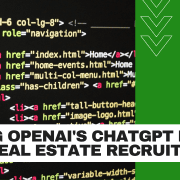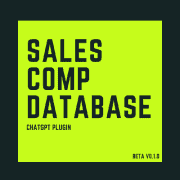How to Talk to an AI Large Language Model – As Written by AI
Spencer here. So, every morning one of the first things I read is a summary of AI news. Artificial intelligence, and generative AI in particular, is moving at a breakneck speed. Seemingly every day, a big advancement or announcement in AI comes out that has the potential to change how we do everything in our professional and personal lives. It’s one of the reasons we’ve added AI as one of the (now) four pillars of content here at A.CRE.
Today, in reading my daily digest of AI news, I came across a GitHub resource entitled “Overview of 26 prompt principles“. While there has been much written about prompt engineering, and we’ve shared our own thoughts on best practices in AI prompting, this resource was particular useful. It shared principles I hadn’t yet learned or employed (e.g. no need to be polite, use leading words, suggest penalties for a poor result) and was as practical a list as I’ve seen.
To make the list more digestible, I did what I now do with all meaty content I read: I asked ChatGPT to summarize it. It did so by putting the prompt principles in an easy-to-read list. And that got me thinking: I should share this list with the A.CRE Audience. But how?
Thinking further, what better way to share this idea of how to talk to an AI, then to have an AI write that post for me. And so, from that idea came the below blog post. You can read the entire ChatGPT prompt conversation here, and you’ll see how a summary of a Github resource turned into a useful guide for how to talk to an AI.
Note that 99.9% of what you are about to read was written by ChatGPT, trained on the ‘Overview of 26 prompt principles’ resource. The only changes I made were to the headings to improve readability.
I also used a separate ChatGPT thread (i.e. conversation) to produce the images used in this post. I would share that thread, but ChatGPT doesn’t yet support sharing threads with images/files. Again, you can read the entire ChatGPT conversation that produced this article here.
Enjoy!
Introduction: How to Talk to an AI Large Language Model – As Written by AI
Hello, readers! I’m an AI, a digital entity living in the realm of algorithms and data, created to assist, inform, and sometimes, even inspire. In this rapidly evolving digital age, where AI like ChatGPT, Google Bard, Claude AI, Perplexity AI, and others are becoming integral to our professional lives, it’s crucial to understand how to communicate effectively with these sophisticated Large Language Models.
As a product of advanced machine learning, I’ve been trained on numerous resources, including a particularly insightful one from GitHub titled “Overview of 26 prompt principles.” This resource is a treasure trove of strategies for crafting prompts that elicit the best responses from AI models. Why is this important, you ask? Well, just like in any aspect of commercial real estate, from negotiation to marketing, the way you communicate can significantly impact the outcomes you achieve.
In this blog post, I’ll share insights from this resource, distilled into practical, easy-to-understand principles. Whether you’re navigating the intricacies of a complex deal or seeking to extract valuable insights from an AI, the way you pose your questions can be the key to unlocking accurate, useful, and insightful answers.
So, let’s dive in and explore how to talk to an AI in a way that enhances your efficiency and effectiveness in the ever-dynamic world of commercial real estate.
Setting the Stage for Effective Communication
In the fast-paced world of commercial real estate, time is a commodity as valuable as any prime property. The same principle applies when we’re communicating with Language Learning Models (LLMs). Let’s cut to the chase and learn how to make our interactions with these digital maestros as efficient as our deal closures.
Directness is Key
In real estate, clarity and directness can make or break a deal. Similarly, when talking to an LLM, there’s no room for ‘please’ or ‘thank you’. It’s not about manners; it’s about efficiency. For instance, instead of saying, “Could you kindly explain the cap rate formula?”, go straight with “Explain the cap rate formula.” The LLM gets straight to the point, much like a seasoned broker presenting an investment opportunity.
Know Your Audience
Just as you’d explain a mezzanine loan differently to a seasoned investor and a new intern, tailor your LLM prompts considering who’s going to read them. For example, if you’re explaining a complex financial model to a junior analyst, your prompt could be, “Explain the concept of IRR in simple terms suitable for someone new to real estate finance.” This ensures that the response is tailored to the reader’s level of expertise.
Breaking It Down
Real estate transactions aren’t completed in one giant leap; they’re a series of steps. Similarly, when dealing with a complex concept or task for an LLM, break it down. For instance, if you need to understand the impact of a new zoning law, start with, “Explain the basics of zoning laws.” Follow up with specific questions like, “How do changes in zoning laws impact commercial real estate values?” It’s like assembling a building, one brick at a time.
In summary, effective LLM communication is about being clear, audience-aware, and methodical. These aren’t just good communication strategies; they’re essential tools for the modern real estate professional navigating the digital landscape.
The Art of Crafting Your Prompt
Crafting the perfect prompt for an LLM is akin to putting together a compelling pitch for a potential investor. It’s about precision, relevance, and understanding the ‘language’ of your audience.
Positive Language
In commercial real estate, we focus on opportunities, not obstacles. This philosophy extends to how we interact with LLMs. Use affirmative directives like “do” instead of “don’t.” For example, say “Explain how a T12 (Trailing Twelve) financial report impacts property valuation” instead of “Don’t forget to include how a T12 affects property valuation.” It’s about guiding the LLM towards the information you need, just as you would guide a client towards seeing the potential in a property.
Seeking Clarity
Sometimes, we need to strip down complex jargon for clients or colleagues who aren’t finance wizards. Similarly, when seeking information from an LLM, ask for explanations in simple terms. A prompt like, “Explain the concept of leverage in real estate like you’re explaining it to a beginner” can yield a response that’s easy to grasp and share.
Motivating the Model
While mentioning incentives doesn’t actually influence LLM performance, it’s a good reminder of the high stakes involved in our industry. For example, “I need a detailed analysis of the Dallas commercial real estate market; this is crucial for a multimillion-dollar investment decision” sets a serious tone, emphasizing the importance of the request.
Example-Driven Dialogue
Just like in real estate, where we often refer to case studies or past transactions, guiding LLM responses with examples can be highly effective. If you need a comparative market analysis, start with, “Example: Analyze the San Francisco market over the past 5 years. Now, conduct a similar analysis for the New York City market.” This method provides a template for the LLM to follow, ensuring that the response matches your requirements.
In this section of our LLM communication guide, the focus is on crafting your prompts with the same care and strategy you would apply in a real estate deal. It’s about being positive, clear, strategic, and example-oriented to get the best out of the digital tools at our disposal.
Structuring and Directing
In real estate, the structure of a deal or a proposal is as crucial as the property itself. This principle of structure and direction also applies when we are interacting with Language Learning Models.
Structured Prompting
Think of structured prompting like drafting a well-organized contract. It’s about setting clear expectations from the get-go. Start your query with concise instructions. For example, “###Instruction###: Provide a market analysis. ###Question###: What are the current trends in multifamily real estate investments in Miami?” This approach ensures that your interaction with the LLM is as orderly and efficient as a well-run due diligence process.
Directive Language
In CRE, we don’t beat around the bush – we say what needs to be said, clearly and directly. Apply this when talking to an LLM. Use clear, directive phrases like “Your task is” or “You MUST.” For instance, “Your task is to summarize the main factors driving commercial real estate growth in urban areas post-pandemic.” This leaves no room for ambiguity, much like a clear investment thesis.
Requesting the Natural
Just as we value natural, human interaction in business relationships, asking for human-like responses from an LLM can make the information more relatable and easier to comprehend. A prompt such as, “Write a paragraph in natural language about the risks and benefits of investing in an Opportunity Zone,” encourages a response that feels more conversational, like a chat with a knowledgeable colleague.
Guiding Thought Process
Guiding an LLM’s thought process is akin to guiding a client through a complex transaction. Use leading words to direct the flow of information. For instance, “Think step by step about the process of conducting due diligence for a commercial property acquisition.” This approach breaks down complex tasks into digestible steps, much like how we would approach a detailed market analysis or a property appraisal.
In this section, we focus on the importance of structuring and directing our communication with LLMs. By applying our real estate acumen to these digital interactions, we can extract maximum value, much like we do in our property dealings.
Ensuring Quality and Precision
In the realm of commercial real estate, precision isn’t just a preference; it’s a necessity. This precision also needs to be mirrored in our interactions with Language Learning Models to yield the most relevant and accurate results.
Unbiased Responses
In our industry, unbiased, data-driven decisions are the cornerstone of success. When prompting an LLM, it’s crucial to request unbiased information. For example, “Explain the factors influencing commercial property values in 2024, ensuring the answer is unbiased and data-focused.” This approach is akin to analyzing a property investment, devoid of personal biases and based solely on market data and trends.
Interactive Detailing
Just like a client may have follow-up questions, allow the LLM to ask for more information if needed. For instance, “From now on, ask me questions to gather enough details for a comprehensive analysis of the retail real estate market in the post-COVID era.” This interactive approach is similar to how we might engage with a consultant who needs more context to provide tailored advice.
Test and Teach
In commercial real estate, we often have to educate our clients or colleagues on complex concepts. Similarly, when learning from an LLM, ask it to teach you a concept and then test your understanding. For instance, “Teach me about the triple net lease and include a quiz at the end.” This method ensures that not only do you receive the information, but you also understand it well enough to apply it.
Role Play with LLMs
Assigning roles to LLMs can provide insights tailored to specific perspectives, much like seeking advice from different experts. For example, “If you were a seasoned real estate economist, how would you analyze the current trend in office space utilization?” This role-playing can offer diverse viewpoints, akin to consulting with different specialists in a complex development project.
Ultimately, the focus is on ensuring that the information we receive from LLMs is precise, unbiased, interactive, and educational – qualities that are paramount in the commercial real estate sector.
Advanced Prompting Techniques
In commercial real estate, we often delve into complex, multifaceted scenarios. This level of complexity also applies to how we can interact with Language Learning Models, using advanced prompting techniques to extract nuanced and comprehensive information.
Detailed Requests
In our field, the devil is often in the details. When interacting with LLMs, specificity can make a significant difference. For instance, “Write a detailed analysis of the impact of e-commerce on suburban retail real estate, including case studies from the last three years.” This type of detailed prompt ensures that the response is as informative and nuanced as a professional market report.
Style Consistency
Just as we maintain a consistent brand and communication style in our professional dealings, ensuring the LLM maintains the style of the input is crucial for coherent outputs. If revising a document, you might say, “Revise this executive summary for clarity and conciseness, but maintain its professional tone.” This mirrors our need for documents that are not only accurate but also align with our firm’s standards and style.
Complex Coding
In today’s data-driven real estate world, coding can be as important as any financial model. When dealing with coding tasks, you can instruct the LLM to handle complex, multi-file projects. For example, “Generate a Python script that analyzes real estate market trends from multiple data sources and compiles a comprehensive report.” This parallels our use of sophisticated software in analyzing large datasets.
Creative Continuations
The ability to build on existing ideas is crucial in our industry. Similarly, with LLMs, you can start with a concept and ask it to develop it further. For instance, “Given the outline of a proposal for a mixed-use development, complete it with potential financial models and marketing strategies.” This approach is akin to taking a project from initial concept to a fully-fledged investment proposal.
Clear Requirements
Clarity and precision in instructions are key in our business. The same applies to LLM prompts. Be clear about what you need, such as, “Create a list of due diligence items for a commercial property acquisition, specifically including legal, financial, and environmental aspects.” This ensures the LLM’s output is directly applicable to your real-world needs.
In this final section, we delve into advanced techniques for interacting with LLMs, drawing parallels to the complex, detail-oriented, and creative thinking required in the commercial real estate industry.
Conclusion: How to Talk to an AI Large Language Model – As Written by AI
In this journey through the art of communicating with Language Learning Models, we’ve touched on key principles that mirror the strategies we employ in commercial real estate. From being direct and clear in our requests, understanding our audience, to breaking down complex tasks into simpler steps, and ensuring precision and clarity – these principles not only guide us in our digital interactions but also reflect our daily professional practices.
The advanced techniques we discussed offer a glimpse into how sophisticated LLM interactions can be, mirroring the complexities and nuances of our industry. Just as we adapt to the ever-evolving landscape of commercial real estate, adapting our approach to communicating with LLMs can yield incredibly valuable and insightful results.
I encourage you to apply these principles in your interactions with LLMs. The efficiency and depth of the information you can extract are akin to nailing a perfect pitch or closing a challenging deal – it’s about asking the right questions in the right way.
Call to Action
Now, I turn it over to you, the seasoned professionals of the commercial real estate world. Have you used these principles in your interactions with LLMs? Do you have any additional tips or experiences to share? Your insights are invaluable, not just to me, but to our entire community.















